Ni-B-PTFE Nanocomposite Co-Deposition on the Surface of 2A12 Aluminum Alloy
Abstract
1. Introduction
2. Materials and Methods
2.1. Materials
2.2. Preparation of Ni-B Coatings
- (1)
- Sequentially measure the weight of the solid experimental chemicals (nickel chloride, sodium borohydride, sodium hydroxide, lead nitrate) using an electronic scale, following the composition of the Ni-B electroless plating solution. Prior to each weighing, position weighing paper beneath the chemicals, and subsequently, after each chemical is weighed, substitute the weighing paper and cleanse the weighing spoon with anhydrous ethanol.
- (2)
- Transfer the measured substances into separate beakers and then add deionized water until the total volume reaches 50 mL. Next, immerse the beakers in a water bath that is heated by electricity and maintains a consistent temperature. Utilize a glass stirring rod to agitate the mixture until all solid compounds have fully dissolved.
- (3)
- Measure the liquid chemical (ethylene diamine) using a 50 mL graduated cylinder and a glass dropper.
- (4)
- Take a 500 mL beaker, mix the complexing agent (ethylene diamine), stabilizing agent (lead nitrate), and nickel salt (nickel chloride) in sequence, and place it in the electrically heated constant temperature water bath.
- (5)
- Slowly pour the reducing agent (sodium borohydride) into the above 500 mL beaker and continuously stir with a glass rod. Add deionized water until it almost reaches the 500 mL mark.
- (6)
- Insert the magnetic rotor into the 500 mL beaker and position the beaker inside a heat-collecting, constant-temperature magnetic stirrer that has been pre-set to the desired procedure temperature. Adjust the rotational speed to 100 revolutions per minute, and gauge the temperature of the plating solution using a thermometer. When the temperature reaches the desired level, use ammonia water and 10% dilute sulfuric acid to modify the pH value. Once the pH meter reading reaches a steady state at the desired value of the process parameters, promptly introduce the pretreated specimens into the chemical plating solution for deposition.
2.3. Orthogonal Experiment
2.4. Coating Performance Testing
2.5. Preparation of Ni-B-PTFE Coatings
3. Results
3.1. Stability of the Plating Solution and Macroscopic Appearance Analysis of Specimens
- (1)
- Stability of the Plating Solution and Analysis
- (2)
- Coating Appearance
3.2. The Effect of Plating Solution Components on Deposition Rate and Hardness
- (1)
- The impact of plating solution components on the rate of deposition:
- (2)
- The impact of plating components of solutions on the substrate’s degree of hardness:
3.3. Adhesion Test of Coating
3.4. Determination of Optimal Preparation Process Parameters for Ni-B Electroless Plating
3.5. The Microstructure of the Surface and Cross-Section of the Optimal Ni-B Coating Test Sample
3.6. Microhardness of the Optimal Ni-B Coating Test Sample
3.7. Energy Spectrum and Microstructure Analysis of the Optimal Ni-B Coating
3.8. Surface Morphology of Ni-B-PTFE Composite Coating
- (1)
- Appearance of nano-PTFE composite co-deposited coating
- (2)
- Microstructure
3.9. Microhardness of the Ni-B-PTFE Composite Coating
3.10. Energy Spectrum of Ni-B-PTFE Composite Coating
3.11. Optimal Structure of Ni-B-PTFE Composite Coating
3.12. Comparison and Analysis of Friction and Wear Performance
3.13. Comparison and Analysis of Electrochemical Corrosion Performance
4. Conclusions
Author Contributions
Funding
Institutional Review Board Statement
Informed Consent Statement
Data Availability Statement
Conflicts of Interest
References
- Haifei, Q. Optimization of Key Performance Parameters of Self-Drafting Ring Spinning. Wool Text. J. 2021, 49, 77–81. [Google Scholar]
- Zhu, G.; Lv, X. Dynamic Balancing Analysis of Spinning Machine Spindle Assembly. Jiangsu Text. 2003, 5, 52–53. [Google Scholar]
- Sundaramali, G.; Aiyasamy, J.P.; Karthikeyan, S.; Kandavel, T.K.; Arulmurugan, B.; Rajkumar, S.; Sharma, S.; Li, C.; Dwivedi, S.P.; Kumar, A.; et al. Experimental investigations of electrodeposited Zn–Ni, Zn–Co, and Ni–Cr–Co–based novel coatings on AA7075 substrate to ameliorate the mechanical, abrasion, morphological, and corrosion properties for automotive applications. Rev. Adv. Mater. Sci. 2023, 62, 20220324. [Google Scholar] [CrossRef]
- Lelevic, A.; Walsh, F.C. Electrodeposition of Ni P alloy coatings: A review. Surf. Coat. Technol. 2019, 369, 198–220. [Google Scholar] [CrossRef]
- Zhang, F.; Örnek, C.; Nilsson, J.-O.; Pan, J. Anodisation of aluminium alloy AA7075—Influence of intermetallic particles on anodic oxide growth. Corros. Sci. 2020, 164, 108319. [Google Scholar] [CrossRef]
- Rodriguez, L.; Paris, J.-Y.; Denape, J.; Delbé, K. Micro-Arcs Oxidation Layer Formation on Aluminium and Coatings Tribological Properties—A Review. Coatings 2023, 13, 373. [Google Scholar] [CrossRef]
- Mei, S.; Zhou, C.; Hu, Z.; Xiao, Z.; Zheng, Q.; Chai, X. Preparation of a Ni-P-nanoPTFE Composite Coating on the Surface of GCr15 Steel for Spinning Rings via a Defoamer and Transition Layer and Its Wear and Corrosion Resistance. Materials 2023, 16, 4427. [Google Scholar] [CrossRef]
- Liu, W.; Qiu, Y.; Liu, Y.; Lin, Y.; Shi, Y.; Mohd, T.; Gao, T. Effects and Mechanism of Nano TiO2 on the Wear Resistance of Microarc Oxidation Coating on D16T Aluminum Alloy. Surf. Technol. 2019, 48, 180–189. [Google Scholar]
- Vitry, V.; Hastir, J.; Mégret, A.; Yazdani, S.; Yunacti, M.; Bonin, L. Recent advances in electroless nickel-boron coatings. Surf. Coat. Technol. 2022, 429, 127937. [Google Scholar] [CrossRef]
- Zhang, D.; Dong, G.; Chen, Y.; Zeng, Q. Electrophoretic deposition of PTFE particles on porous anodic aluminum oxide film and its tribological properties. Appl. Surf. Sci. 2014, 290, 466–474. [Google Scholar] [CrossRef]
- Vencl, A.; Bobić, I.; Vučetić, F.; Bobić, B.; Ružić, J. Structural, mechanical and tribological characterization of Zn25Al alloys with Si and Sr addition. Mater. Des. 2014, 64, 381–392. [Google Scholar] [CrossRef]
- Bukvić, M.; Gajević, S.; Skulić, A.; Savić, S.; Ašonja, A.; Stojanović, B. Tribological Application of Nanocomposite Additives in Industrial Oils. Lubricants 2023, 12, 6. [Google Scholar] [CrossRef]
- Nemane, V.; Chatterjee, S. Evaluation of microstructural, mechanical, and tribological characteristics of Ni-B-W-SiC electroless composite coatings involving multi-pass scratch test. Mater. Charact. 2021, 180, 111414. [Google Scholar] [CrossRef]
- Li, J.; Liu, Y.; Zhang, Q. Research on Composite Chemical Plating of Nickel-Phosphorus Artificial Diamond on Spinning Cup. J. Text. Res. 2002, 23, 47–48. [Google Scholar]
- Wu, J.; Kuang, T. Study on Chemical Plating of Ni-P-Diamond Composite Coating and Deposition of Diamond Powder on Cemented Carbide Surface. Tool Technol. 2005, 39, 21–23. [Google Scholar]
- Wang, Y.; Wang, H.; Wu, W.; Li, Z. Process Study of Mid-Temperature Chemical Nickel-Phosphorus Plating Coating on 2A12 Aluminum Alloy. J. Beihua Univ. Aerosp. Technol. 2015, 25, 33–36. [Google Scholar]
- Vitry, V.; Bonin, L. Effect of temperature on ultrasound-assisted electroless nickel-boron plating. Ultrason. Sonochem. 2019, 56, 327–336. [Google Scholar] [CrossRef] [PubMed]
- Pancrecious, J.K.; Deepa, J.P.; Jayan, V.; Bill, U.S.; Rajan, T.P.D.; Pai, B.C. Nanoceria induced grain refinement in electroless Ni-B-CeO2 composite coating for enhanced wear and corrosion resistance of Aluminium alloy. Surf. Coat. Technol. 2018, 356, 29–37. [Google Scholar] [CrossRef]
- Krishnaveni, K.; Narayanan, T.S.N.S.; Seshadri, S.K. Corrosion resistance of electrodeposited Ni–B and Ni–B–Si3N4 composite coatings. J. Alloys Compd. 2009, 480, 765–770. [Google Scholar] [CrossRef]
- Azadi, M.; Parast, M.S.A. Data analysis of high-cycle fatigue testing on piston aluminum-silicon alloys under various conditions: Wear, lubrication, corrosion, nano-particles, heat-treating, and stress. Data Brief 2022, 41, 107984. [Google Scholar] [CrossRef]
- Guo, Q.; Huang, Y.; Xu, M.; Huang, Q.; Cheng, J.; Yu, S.; Zhang, Y.; Xiao, C. PTFE porous membrane technology: A comprehensive review. J. Membr. Sci. 2022, 664, 121115. [Google Scholar] [CrossRef]
- Vidakis, N.; Antoniadis, A.; Bilalis, N. The VDI 3198 indentation test evaluation of a reliable qualitative control for layered compounds. J. Mater. Process. Technol. 2003, 143, 481–485. [Google Scholar] [CrossRef]
- Zheng, Q.; Mei, S.; Xiao, Z.; Yang, J.; Chen, Z.; Xu, Q.; Guryev, A.; Lygdenov, B. Effect of cooling methods on the tribological, oxidation and corrosion properties of CeO2 composite boronizing coatings on 4Cr5MoSiV1 steel. J. Mater. Res. Technol. 2024, 30, 3807–3821. [Google Scholar] [CrossRef]
- Michi, R.A.; Sisco, K.; Bahl, S.; Yang, Y.; Poplawsky, J.D.; Allard, L.F.; Dehoff, R.R.; Plotkowski, A.; Shyam, A. A creep-resistant additively manufactured Al-Ce-Ni-Mn alloy. Acta Mater. 2022, 227, 117699. [Google Scholar] [CrossRef]
- Khelge, S.; Kumar, V.; Shetty, V.; Kumaraswamy, J. Effect of reinforcement particles on the mechanical and wear properties of aluminium alloy composites: Review. Mater. Today Proc. 2022, 52, 571–576. [Google Scholar] [CrossRef]
- Abdel-Gawad, S.A.; Sadik, M.A.; Shoeib, M.A. Preparation and properties of a novel nano Ni-B-Sn by electroless deposition on 7075-T6 aluminum alloy for aerospace application. J. Alloys Compd. 2019, 785, 1284–1292. [Google Scholar] [CrossRef]
- Pancrecious, J.K.; Gopika, P.S.; Suja, P.; Ulaeto, S.B.; Gowd, E.B.; Rajan, T.P.D. Role of layered double hydroxide in enhancing wear and corrosion performance of self-lubricating hydrophobic Ni-B composite coatings on aluminium alloy. Colloids Surf. A Physicochem. Eng. Asp. 2022, 634, 128017. [Google Scholar] [CrossRef]
- Huang, P.-C.; Hou, K.-H.; Hong, J.-J.; Lin, M.-H.; Wang, G.-L. Study of fabrication and wear properties of Ni–SiC composite coatings on A356 aluminum alloy. Wear 2021, 477, 203772. [Google Scholar] [CrossRef]
- Wang, C.; Su, Y.; Ouyang, Q.; Zhang, D. Enhanced mechanical behavior and fabrication of graphite flakes covered by aligned graphene nanoplatelets reinforced 2A12 aluminum composites. Vacuum 2021, 188, 110150. [Google Scholar] [CrossRef]
- Das, A.K. Effect of rare earth oxide additive in coating deposited by laser cladding: A review. Mater. Today Proc. 2022, 52, 1558–1564. [Google Scholar] [CrossRef]
- Mohanty, D.; Barman, T.K.; Sahoo, P. Characterisation and corrosion study of electroless Nickel-Boron coating reinforced with alumina nanoparticles. Mater. Today Proc. 2019, 19, 317–321. [Google Scholar] [CrossRef]
- Wan, Y.; Yu, Y.; Cao, L.; Zhang, M.; Gao, J.; Qi, C. Corrosion and tribological performance of PTFE-coated electroless nickel boron coatings. Surf. Coat. Technol. 2016, 307, 316–323. [Google Scholar] [CrossRef]
- Wu, Y.; Xu, K.; Dai, X.; Zhang, M.; Jiang, G.; Zhu, H.; Liu, Y.; Zhang, Z. Effect of laser irradiation on high-temperature crystallization behavior, oxidation resistance, and corrosion performance evaluation of electrodeposited amorphous Ni-P coatings. J. Non-Cryst. Solids 2022, 589, 121647. [Google Scholar] [CrossRef]
- Vitry, V.; Delaunois, F. Formation of borohydride-reduced nickel–boron coatings on various steel substrates. Appl. Surf. Sci. 2015, 359, 692–703. [Google Scholar] [CrossRef]
- Khan, U.; Nairan, A.; Irfan, M.; Naz, S.; Wu, D.; Gao, J. Magnetic properties of Ni/BiFeO3 hybrid nanostructures. J. Alloys Compd. 2022, 912, 165133. [Google Scholar] [CrossRef]
- Li, L.; Liu, P.; Zhou, Y.; Duan, H.; Long, M.; Chen, D. Mechanical properties and electronic structures of borides in Ni-Co-B alloy system. Mater. Lett. 2022, 309, 131312. [Google Scholar] [CrossRef]
- Bonin, L.; Vitry, V.; Delaunois, F. Replacement of Lead stabilizer in electroless Nickel-Boron baths: Synthesis and characterization of coatings from bismuth stabilized bath. Sustain. Mater. Technol. 2020, 23, e00130. [Google Scholar] [CrossRef]
- Zalzalah, M.; Lewis, R.; Slatter, T. A new predictive model for normal and compound impact wear. Wear 2021, 480, 203954. [Google Scholar] [CrossRef]
- Pujar, V.; Devarajaiah, R.M.; Suresha, B.; Bharat, V. A review on mechanical and wear properties of fiber-reinforced thermoset composites with ceramic and lubricating fillers. Mater. Today Proc. 2021, 46, 7701–7710. [Google Scholar] [CrossRef]
- Saisnith, V.; Fridrici, V. A study of the wear damage of a PTFE coating: The effects of temperature and environment on its mechanical and tribological properties. Wear 2021, 480, 203946. [Google Scholar] [CrossRef]
- Wang, W.; Shen, G.; Zhang, Y.; Zhu, Z.; Li, C.; Lu, H. Dynamic reliability analysis of mechanical system with wear and vibration failure modes. Mech. Mach. Theory 2021, 163, 104385. [Google Scholar] [CrossRef]
- Moghaddam, P.V.; Hardell, J.; Vuorinen, E.; Prakash, B. Effect of retained austenite on adhesion-dominated wear of nanostructured carbide-free bainitic steel. Tribol. Int. 2020, 150, 106348. [Google Scholar] [CrossRef]
- Alam, K.I.; Bragaw, P.; Burris, D.L. Isolating the tribochemical and mechanical effects of nanofillers on PTFE wear. Wear 2022, 494, 204256. [Google Scholar] [CrossRef]
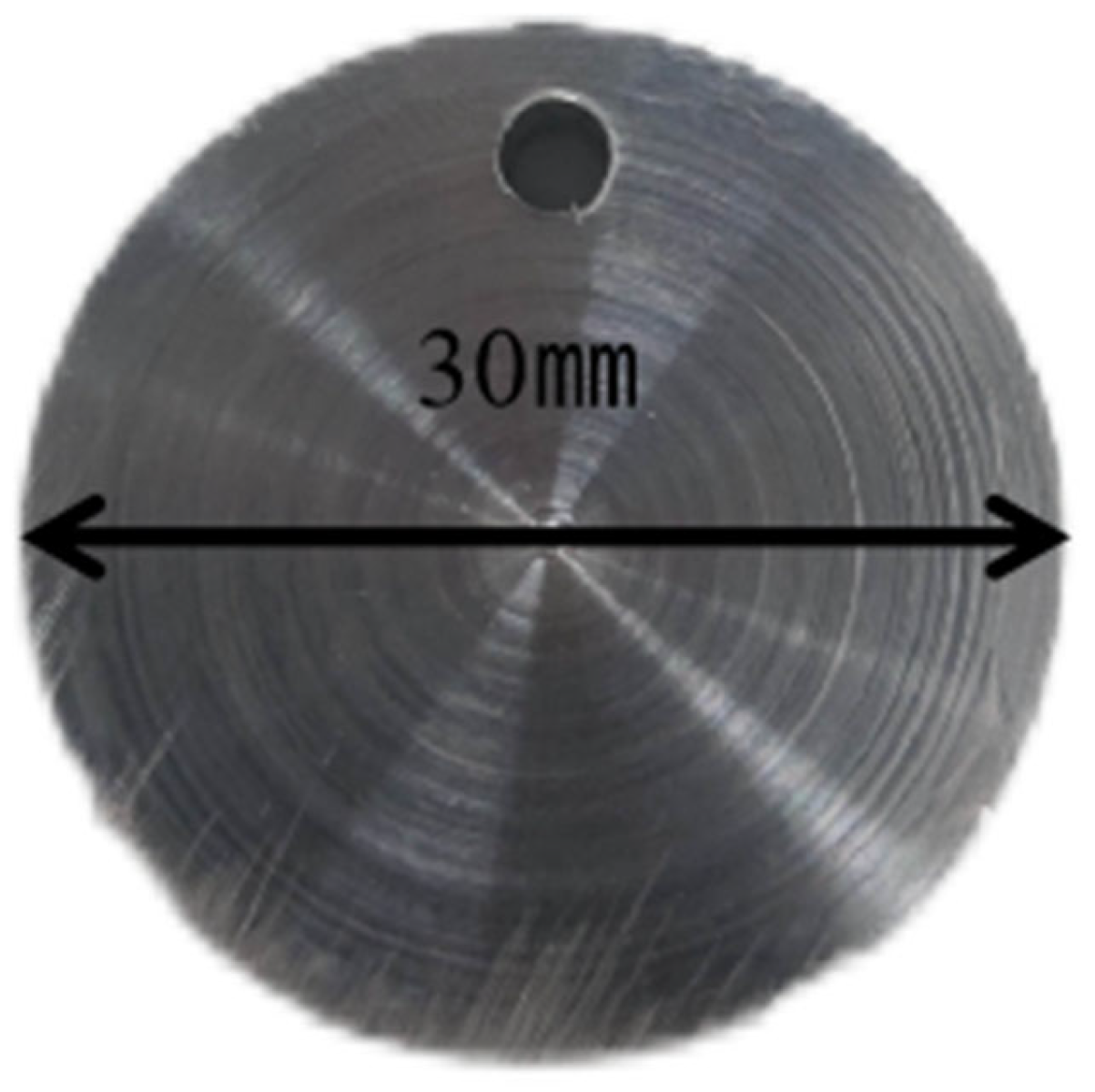

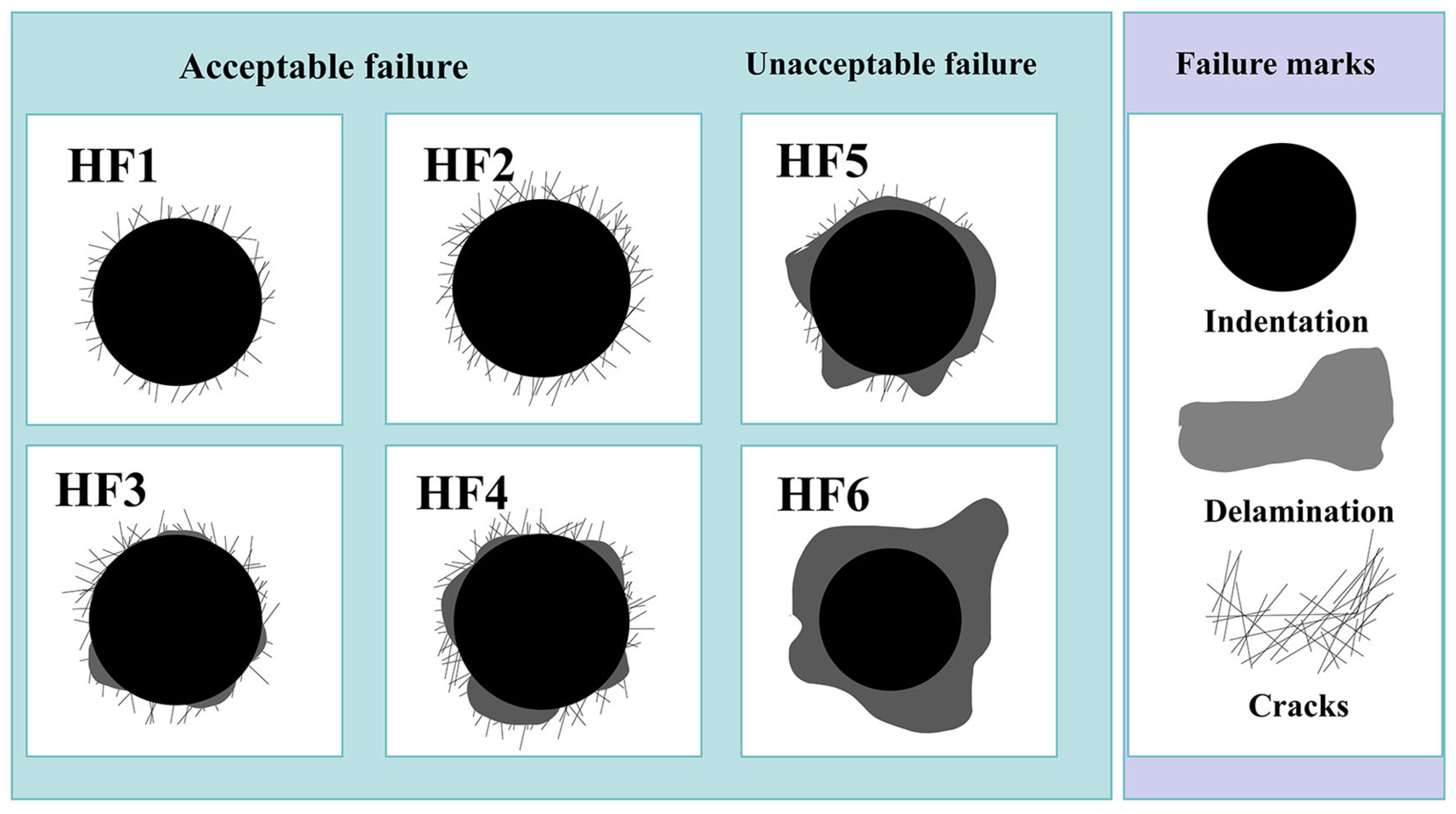

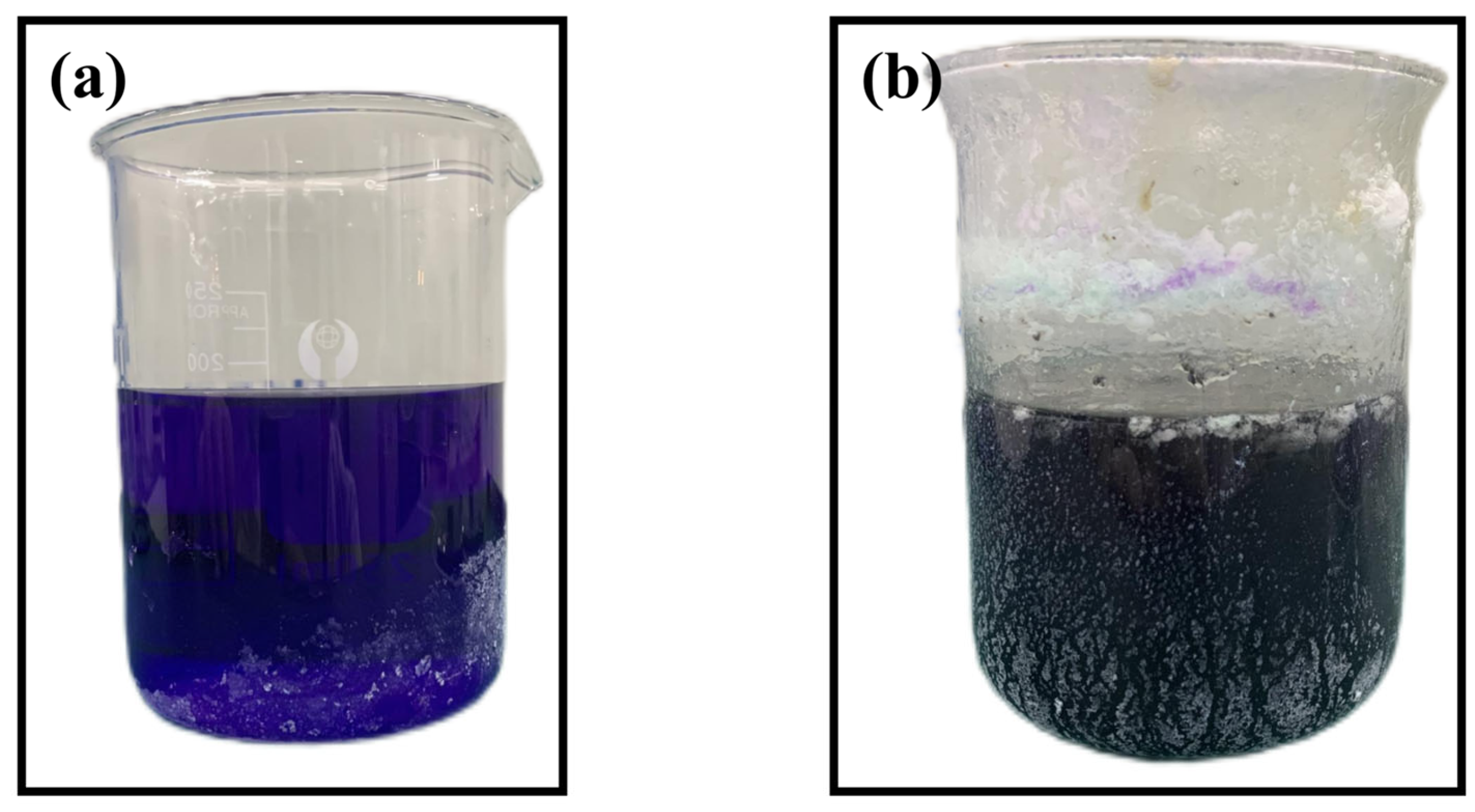

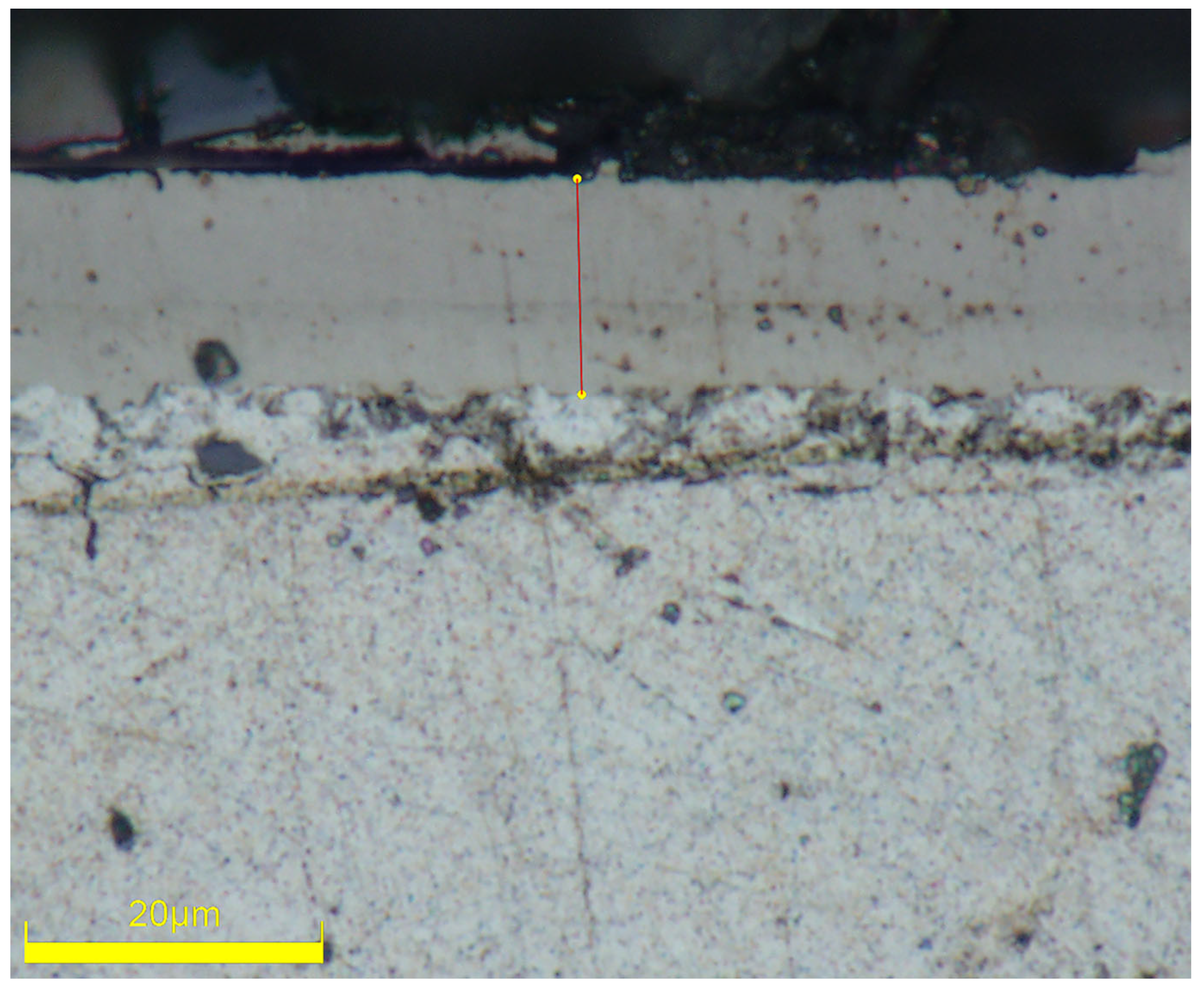
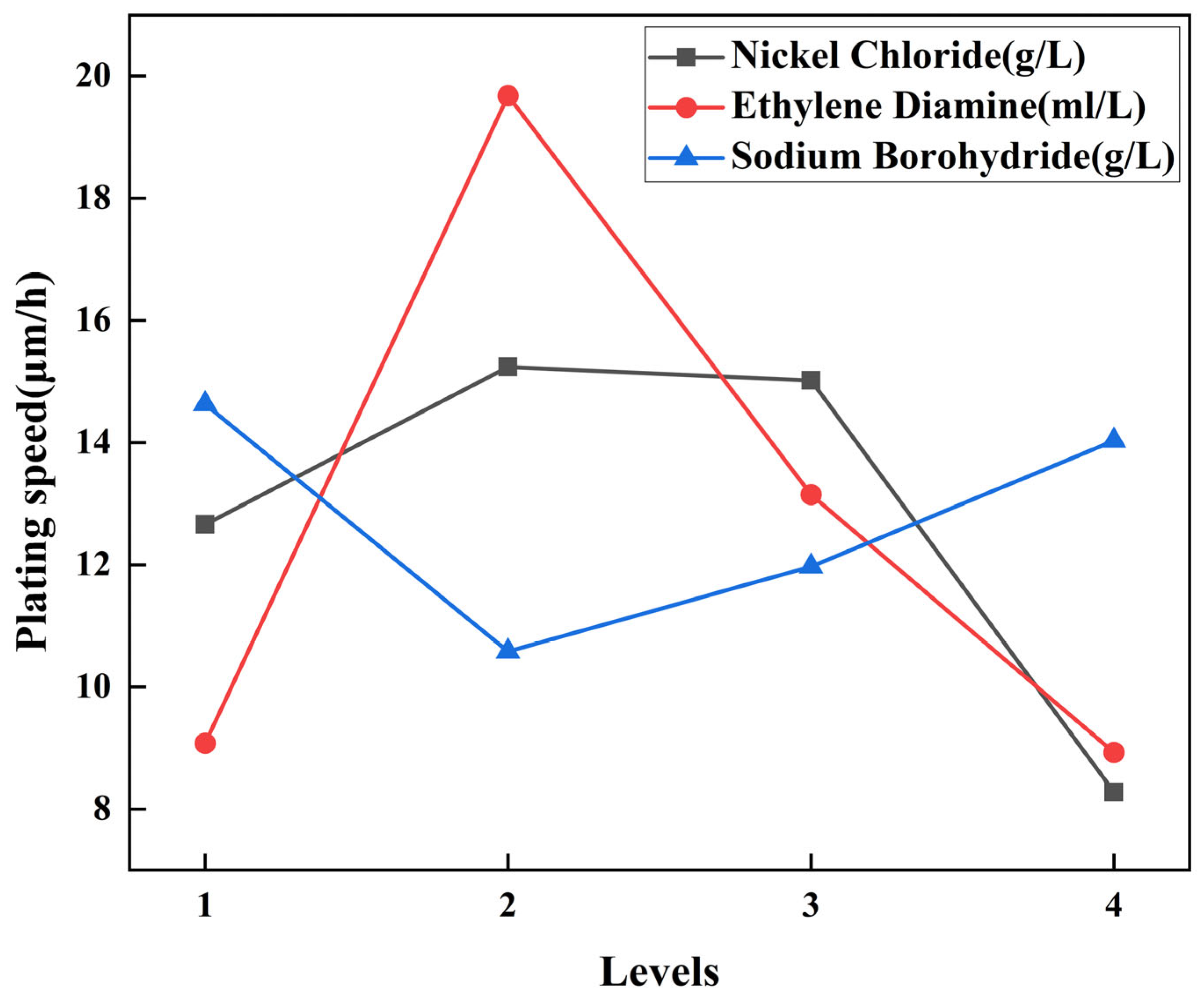

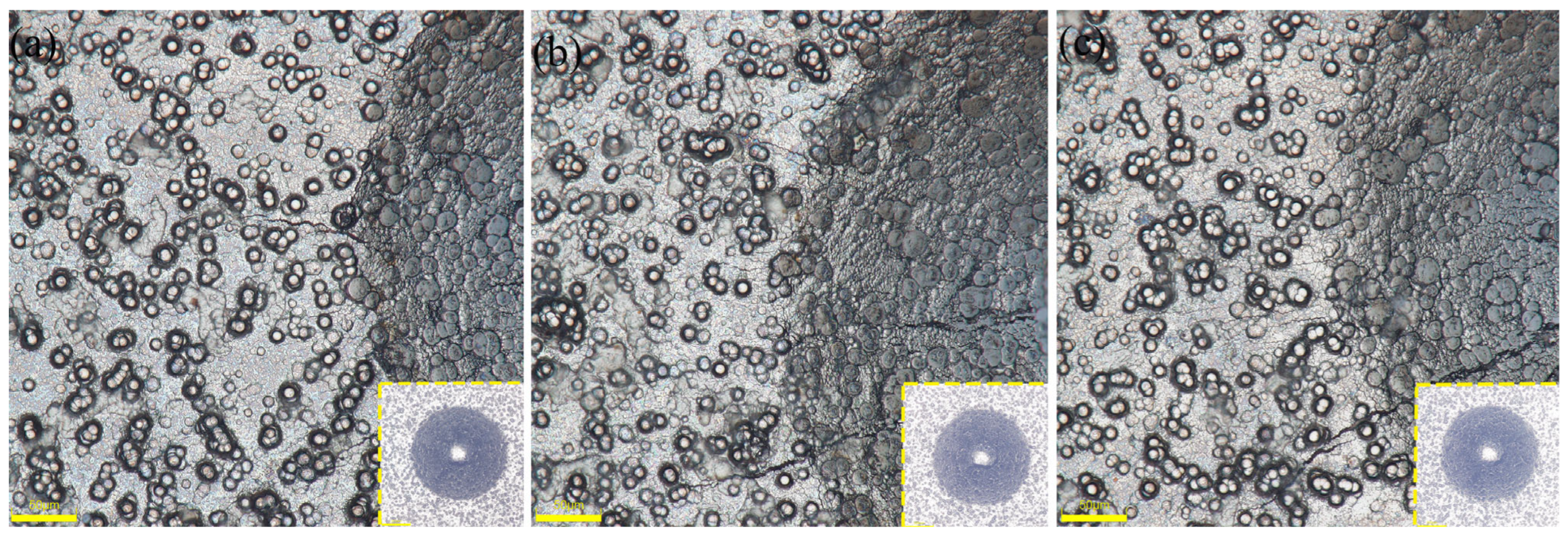

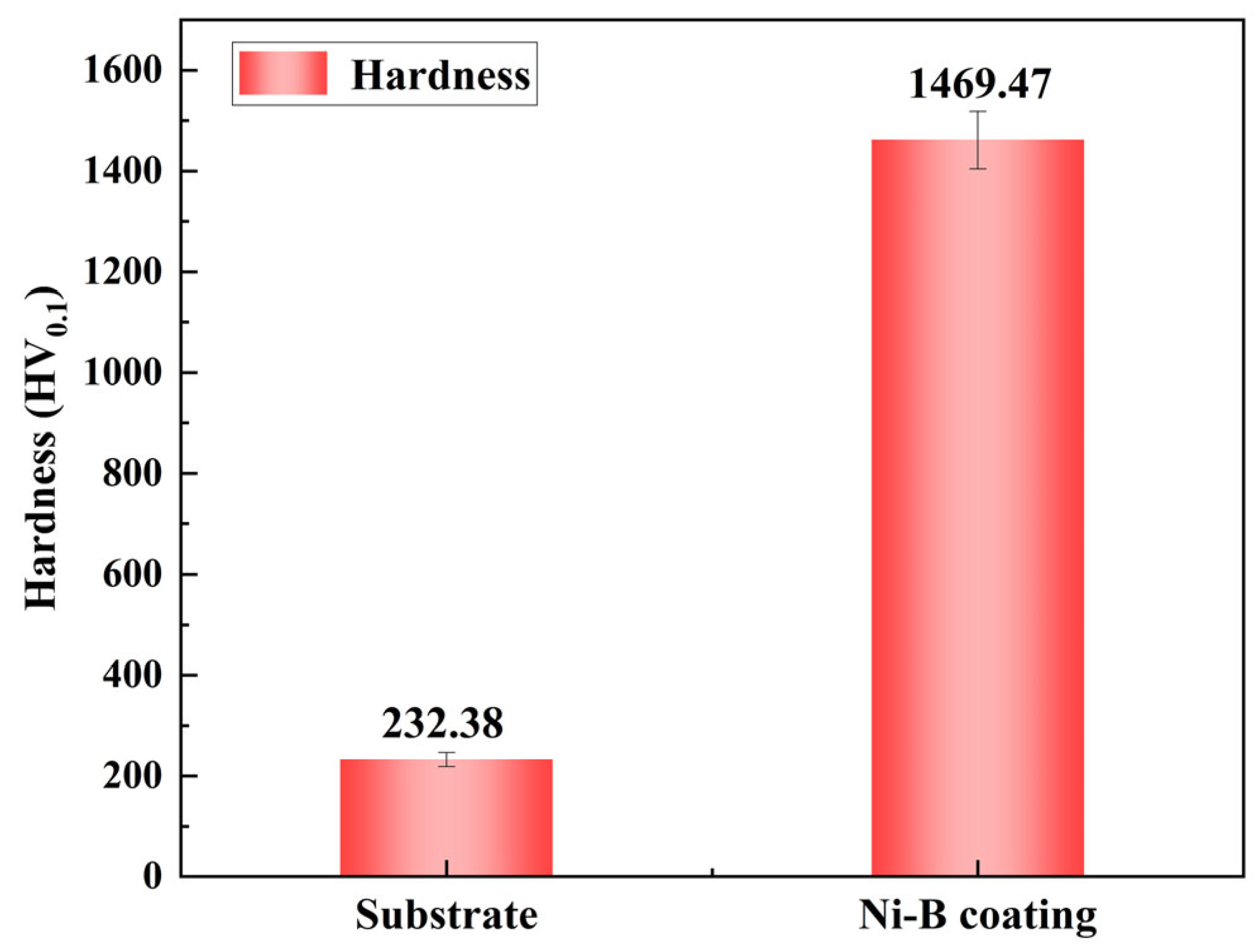

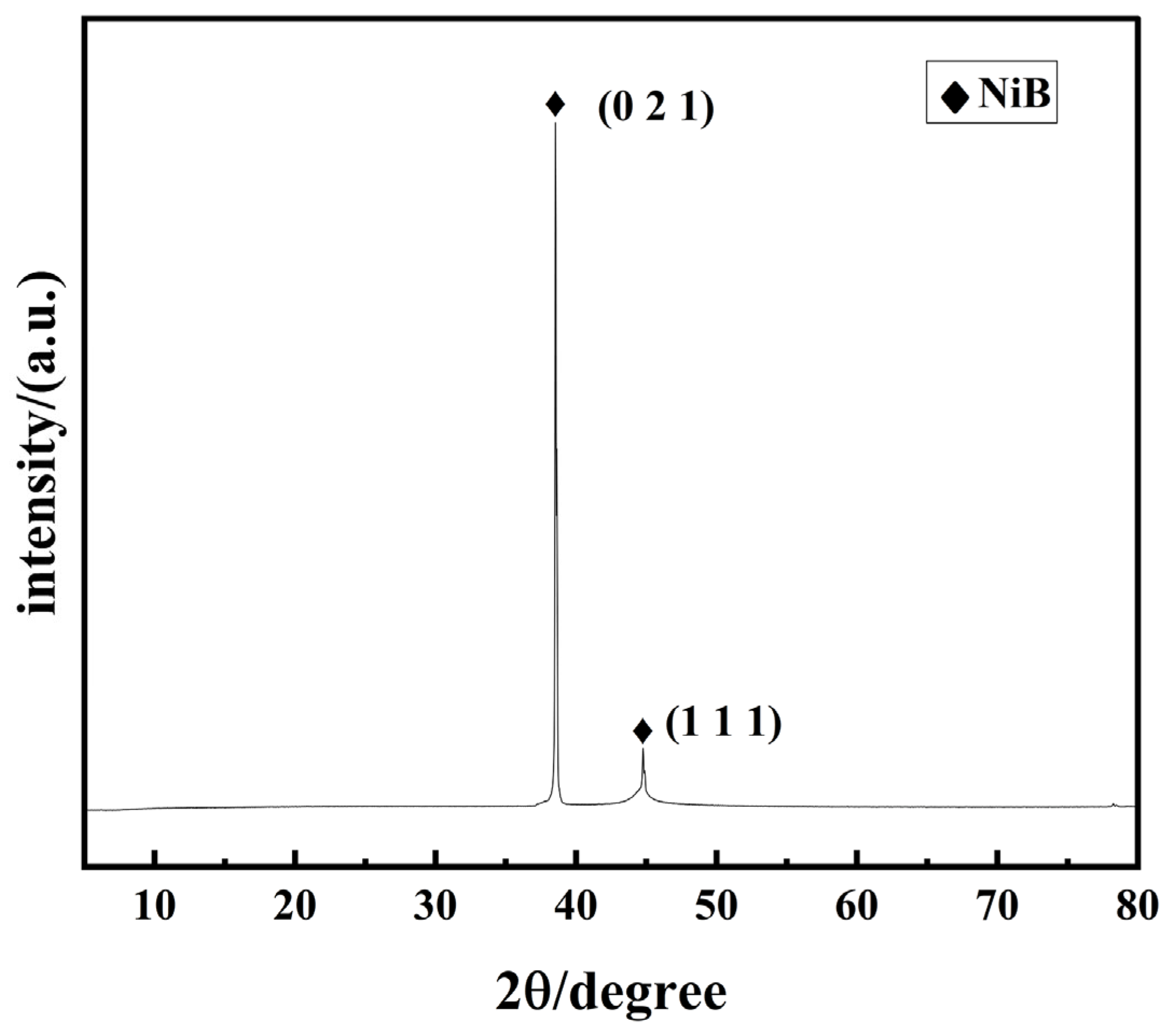
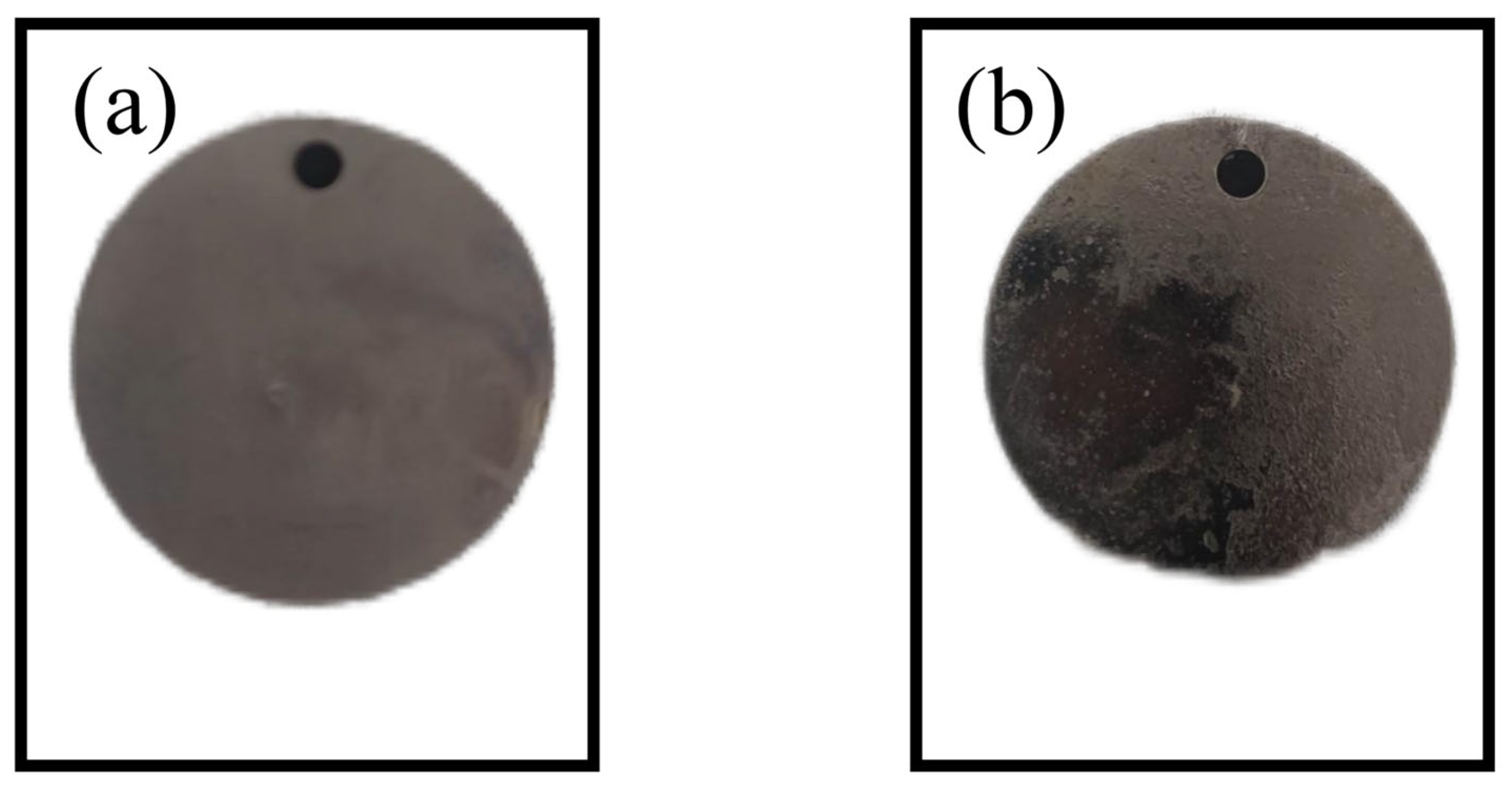
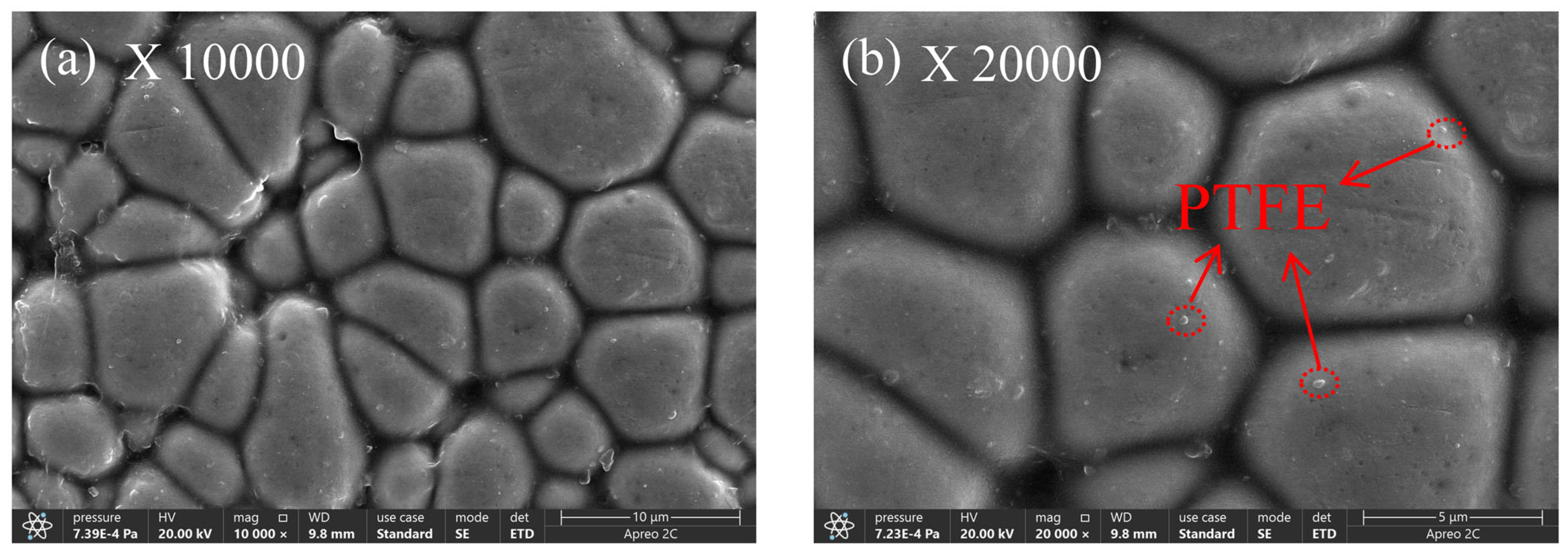
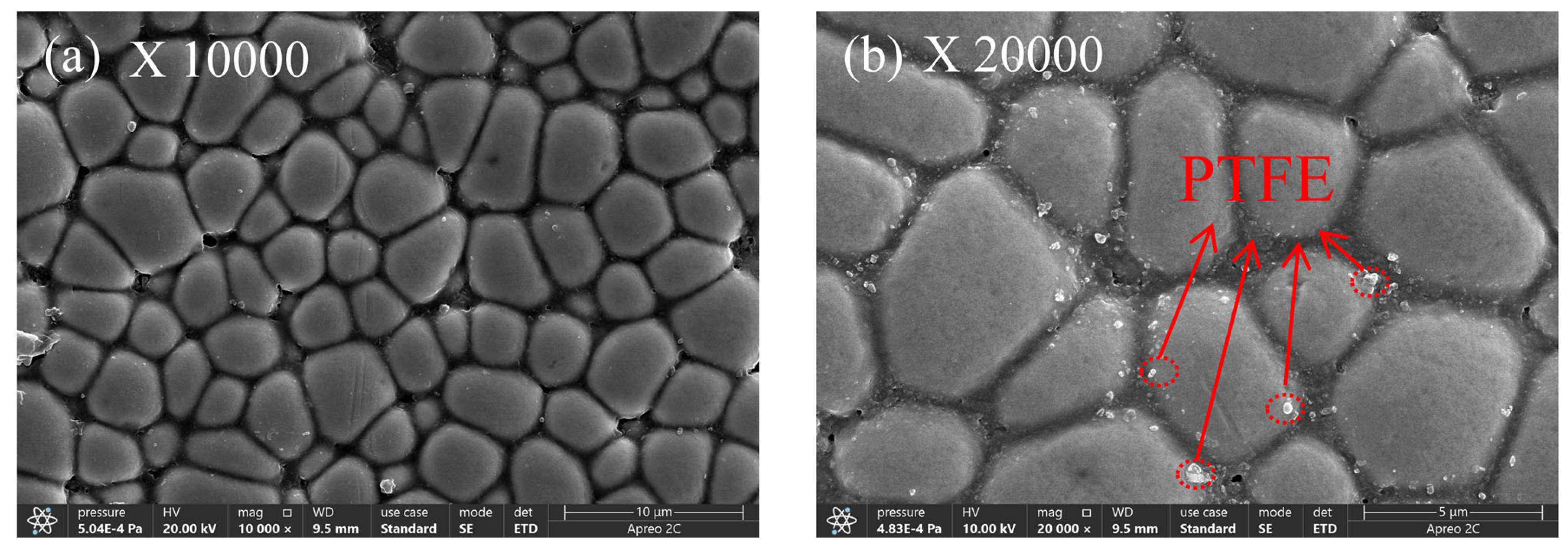
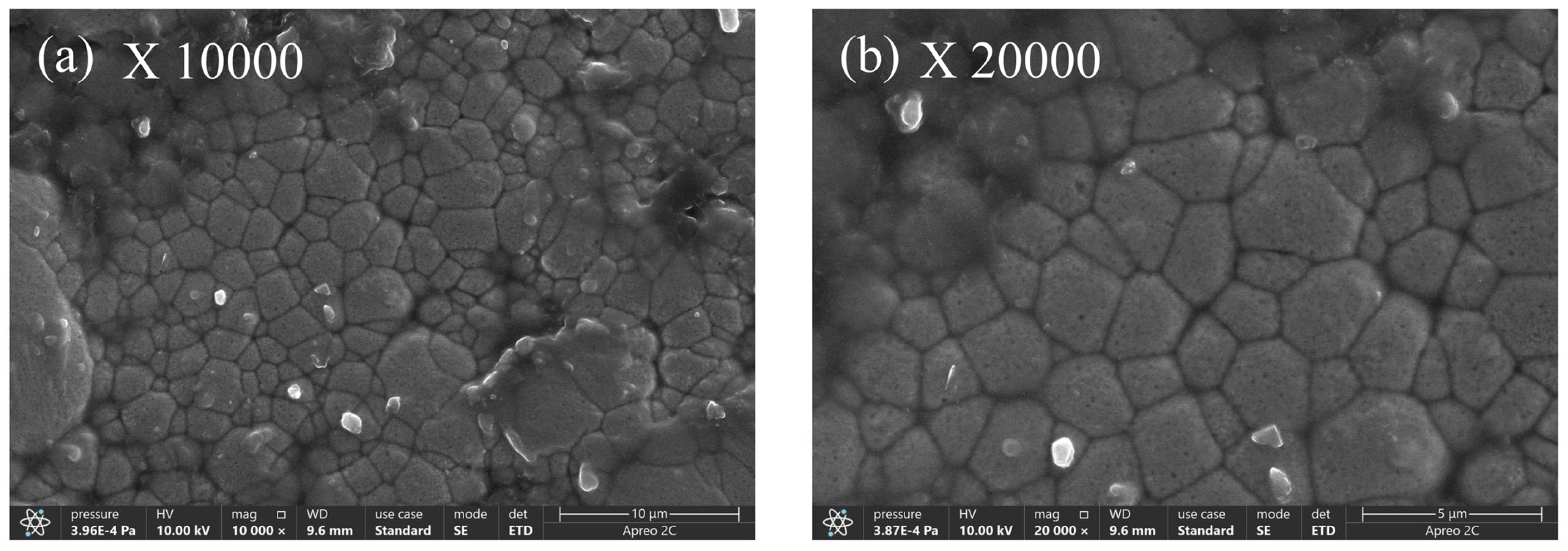
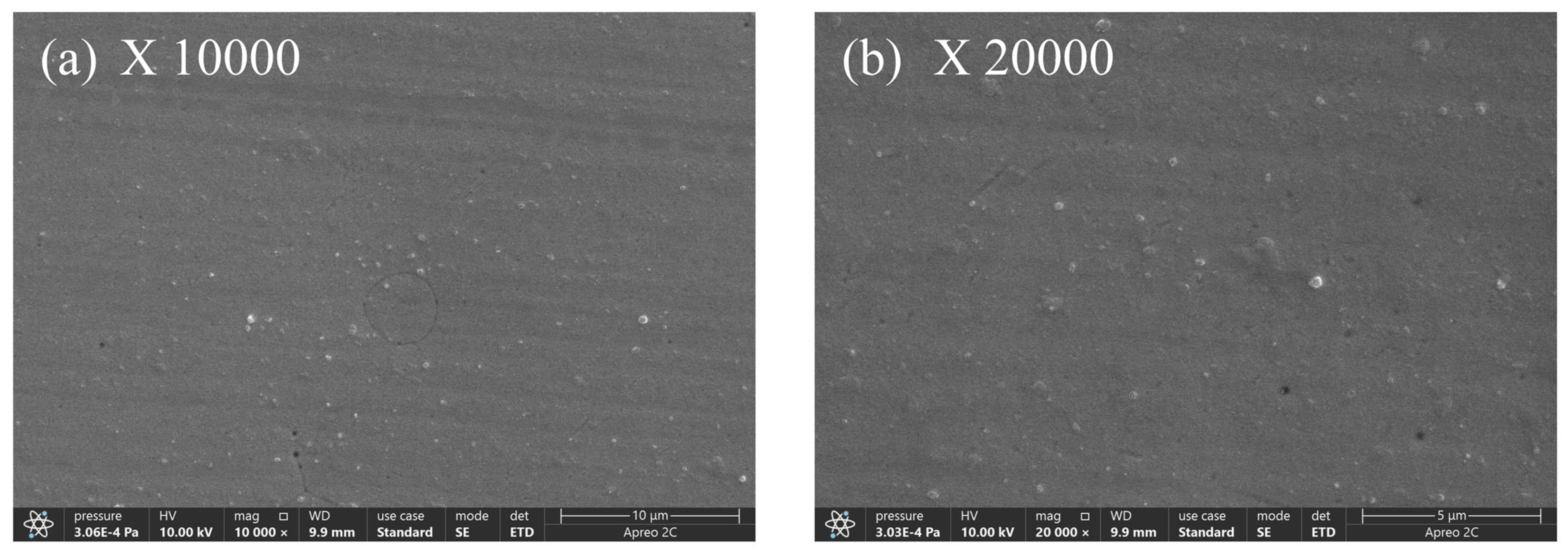

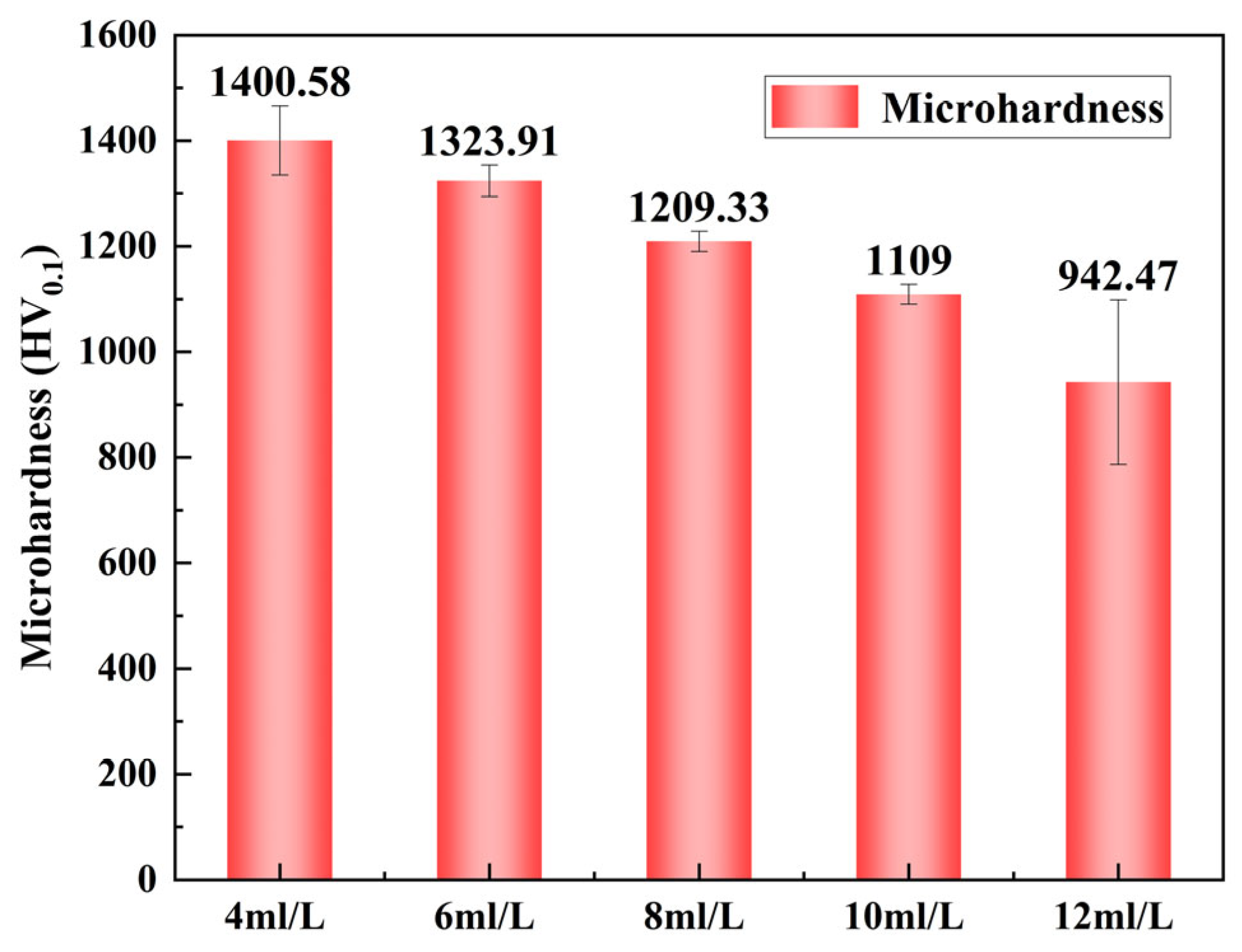
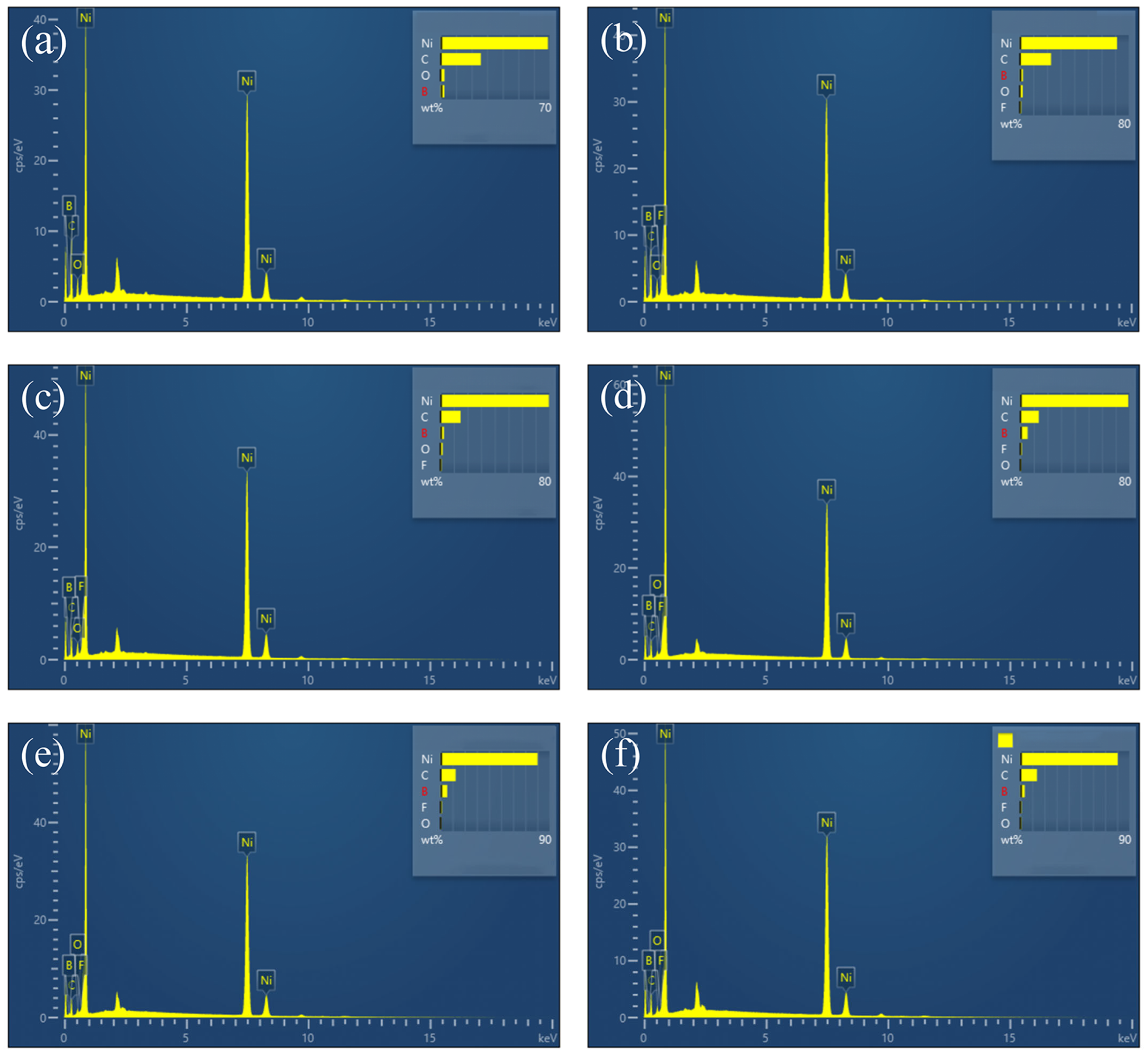

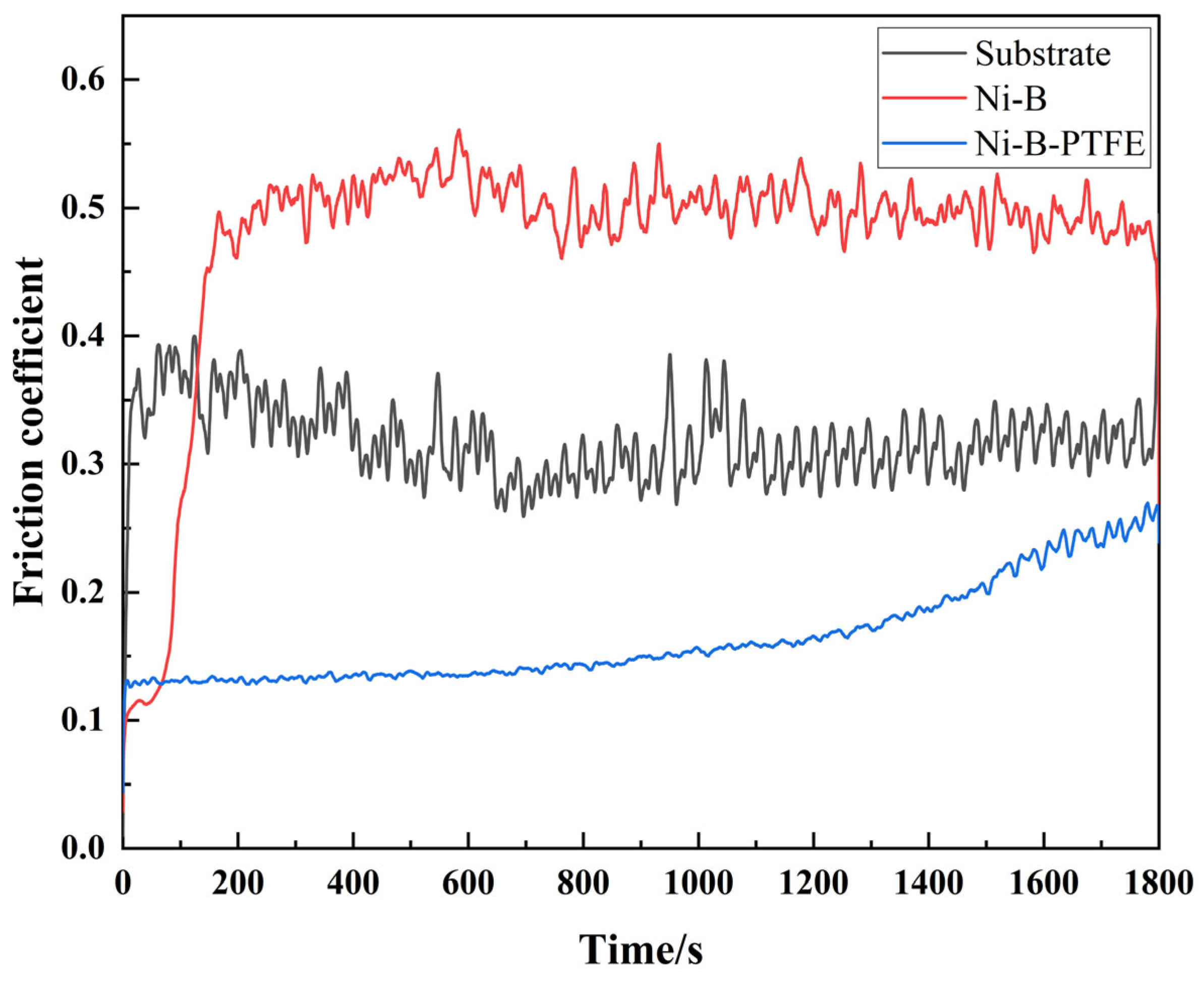
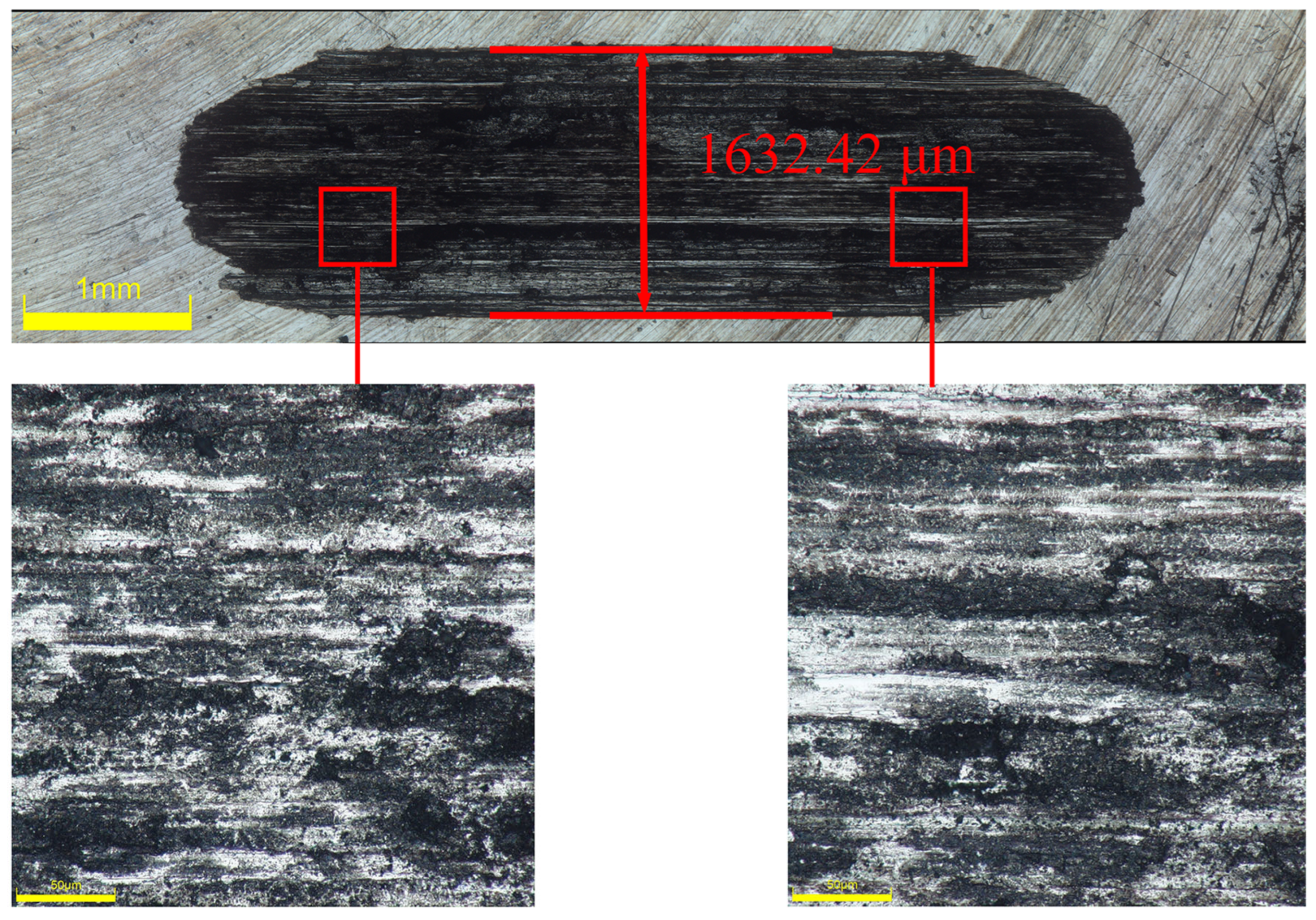
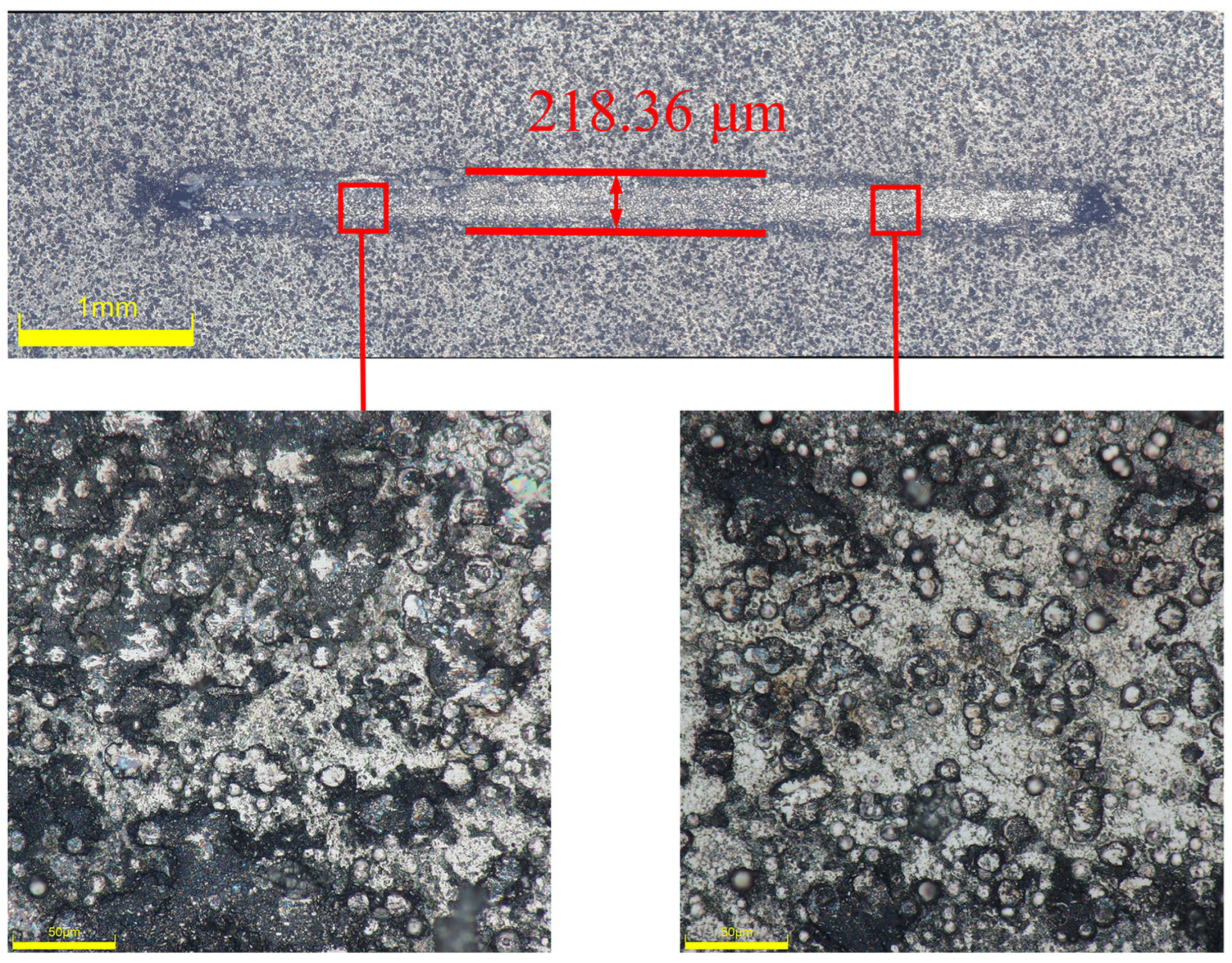
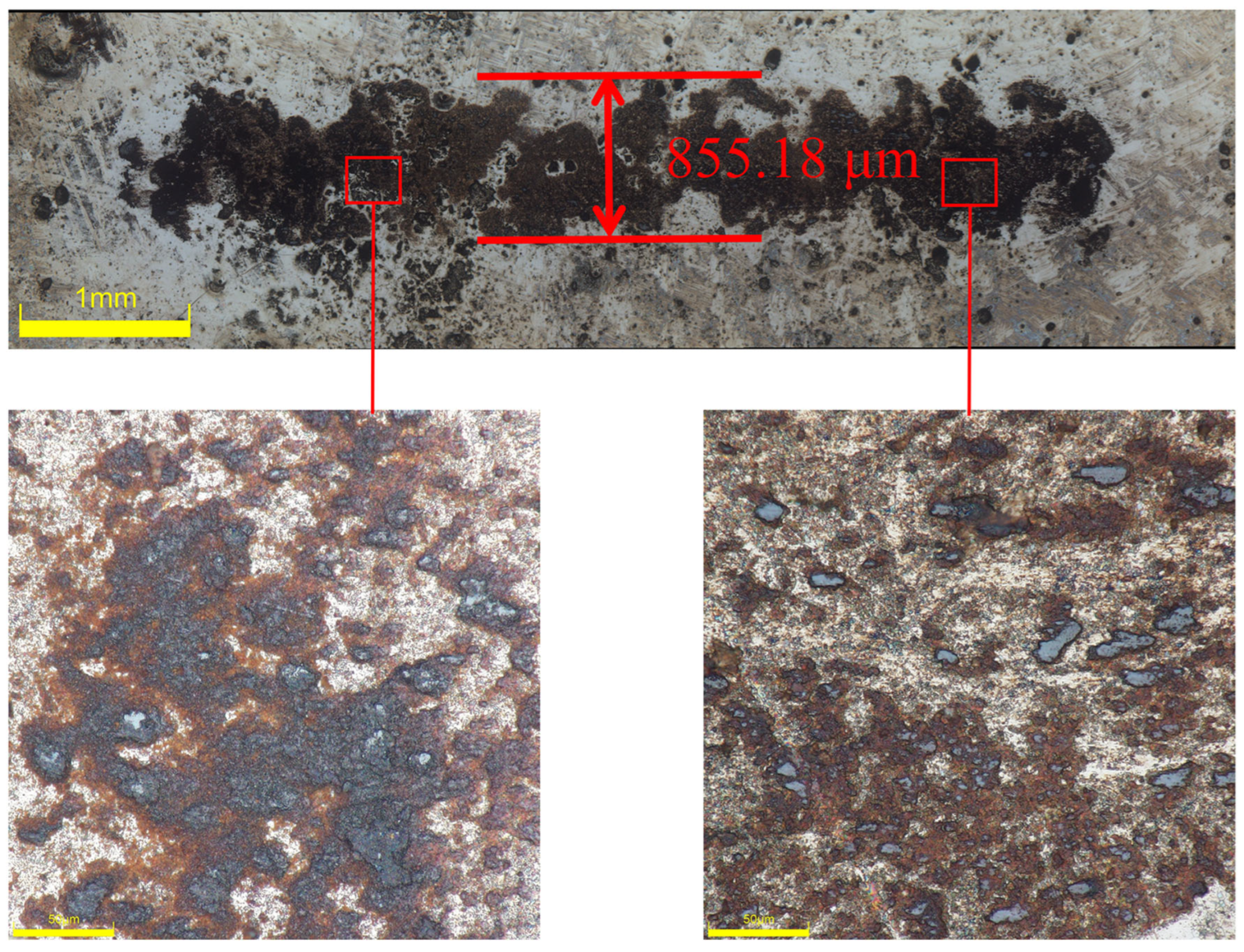
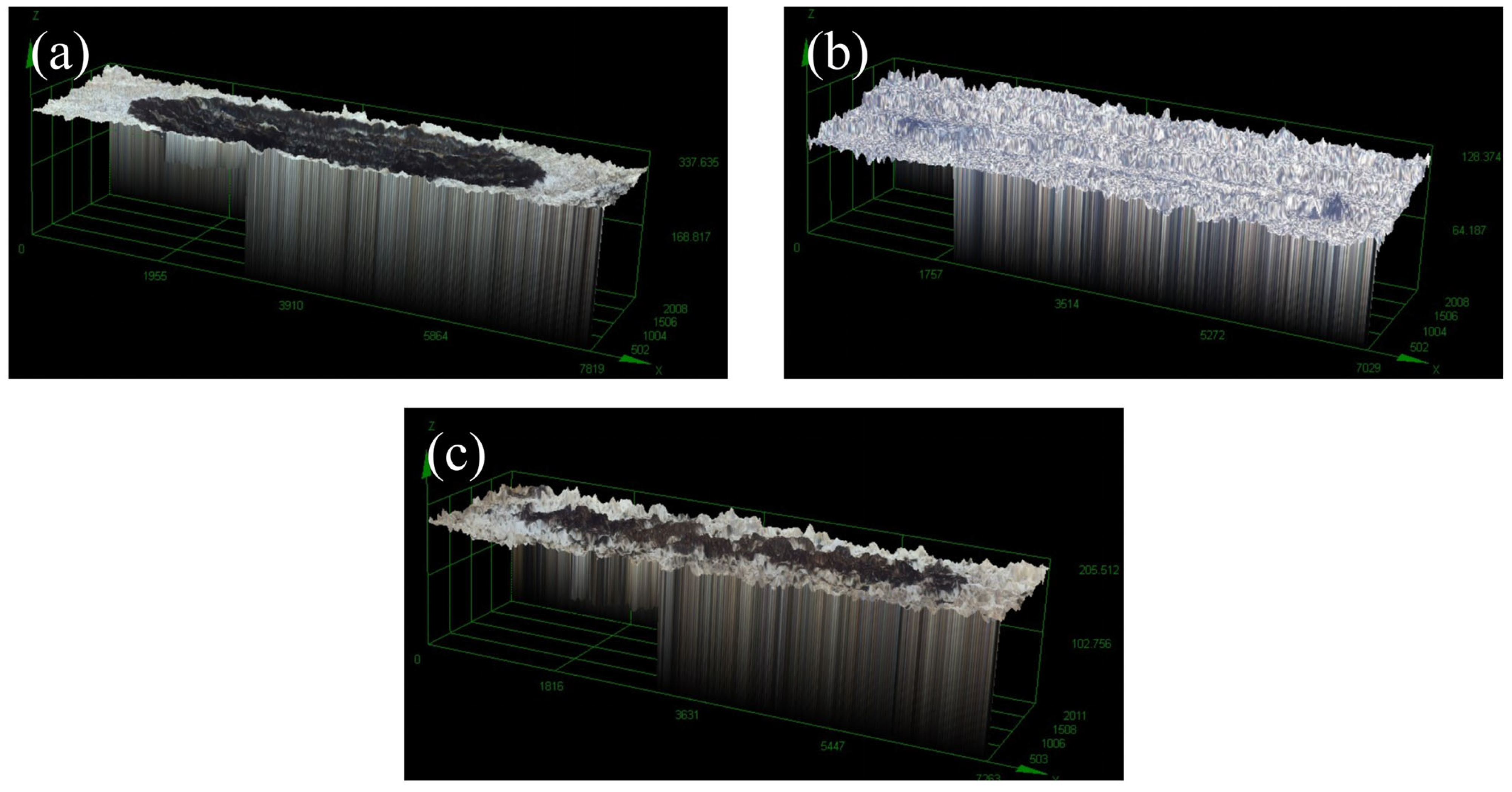
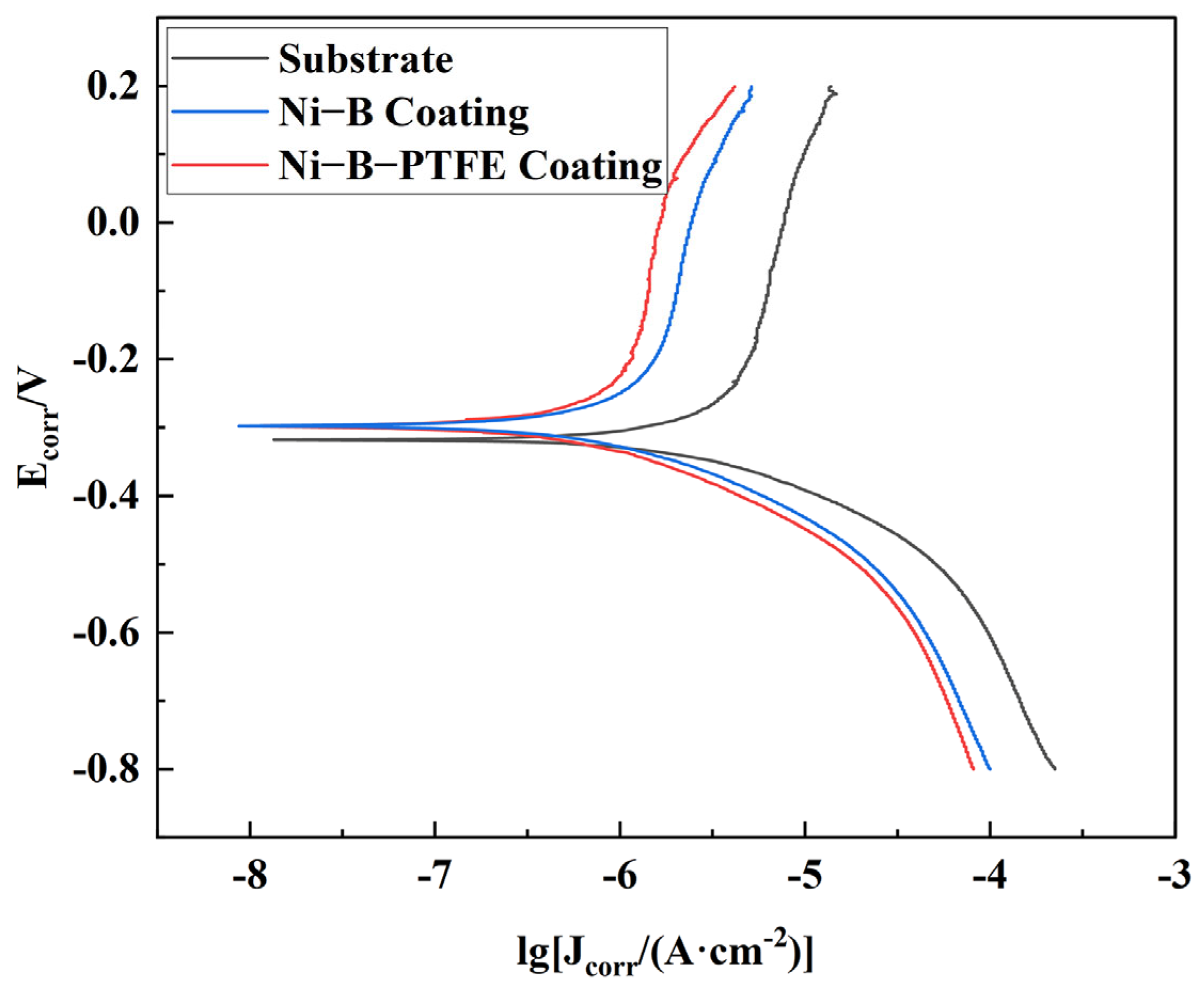

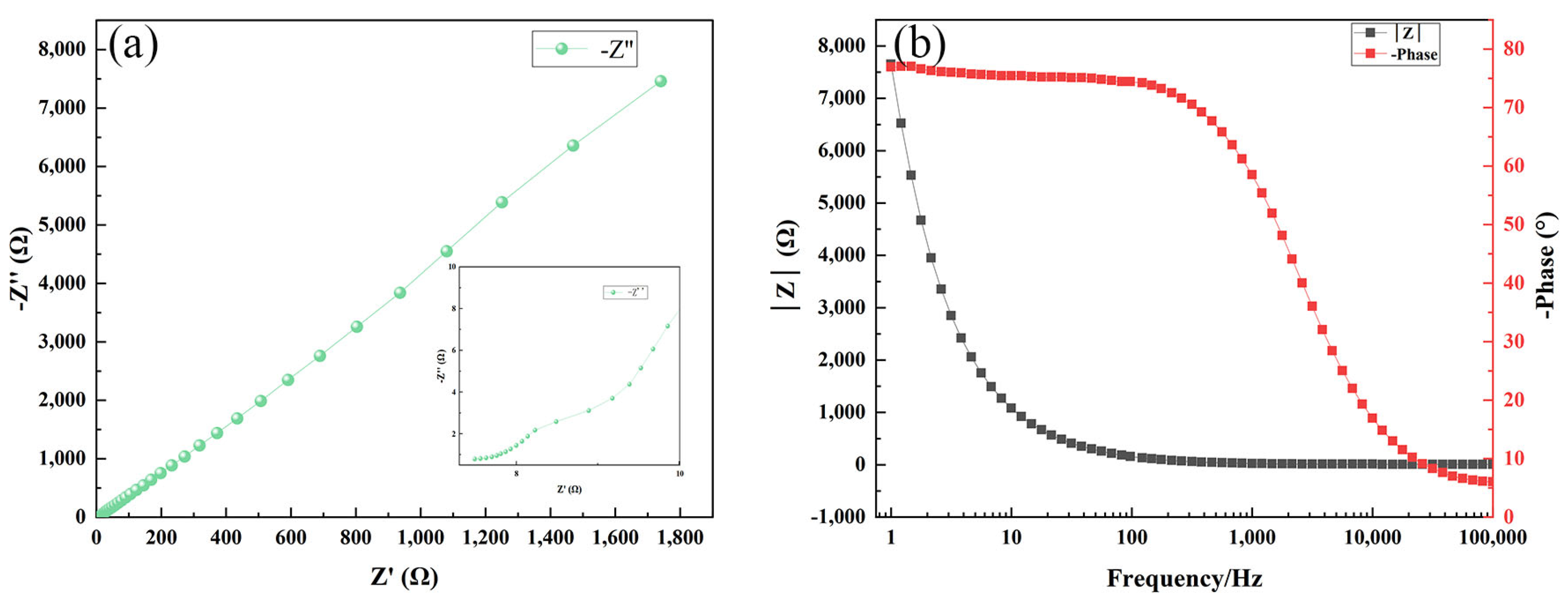
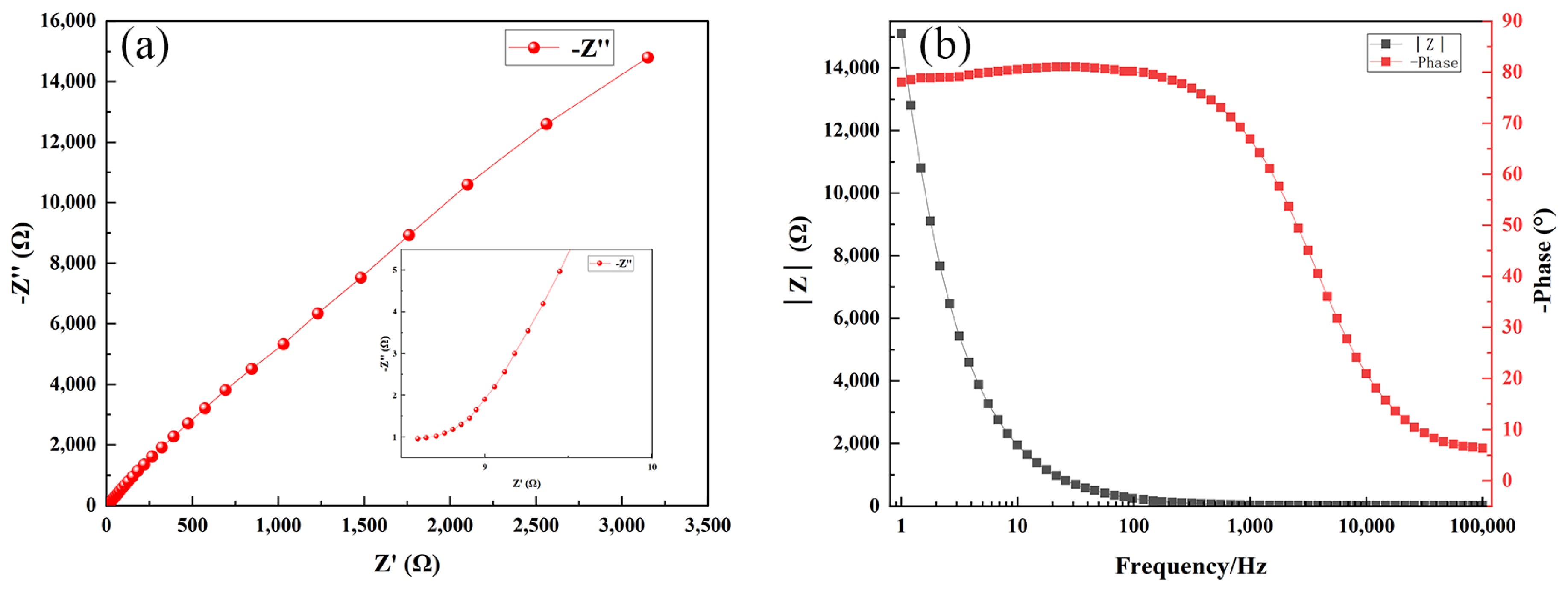
| Fe | Si | Mn | Ni | Cu | Ti | Zn | Mg | Al |
|---|---|---|---|---|---|---|---|---|
| ≤0.5 | ≤0.5 | 0.3~0.9 | ≤0.1 | 3.8~4.9 | ≤0.15 | ≤0.3 | 1.2~1.8 | Bal. |
| Composition or Process Parameters | Concentration or Parameters |
|---|---|
| Nickel chloride (NiCl2) | 20–35 g/L |
| Ethylene diamine (C2H8N2) | 40–80 mL/L |
| Sodium borohydride (NaBH4) | 0.6–1.2 g/L |
| Sodium hydroxide (NaOH) | 90 g/L |
| Lead nitrate (Pb(NO3)2) | 30 mg/L |
| PH | ≥12 |
| Temperature | 90 °C |
| Factors | A NiCl2 (g/L) | B C2H8N2 (mL/L) | C NaBH4 (g/L) | |
|---|---|---|---|---|
| Levels | ||||
| 1 | 20 | 50 | 0.6 | |
| 2 | 25 | 60 | 0.8 | |
| 3 | 30 | 70 | 1.0 | |
| 4 | 35 | 80 | 1.2 | |
| Surface Active Agent Content (mg/L) | PTFE Concentration (mL/L) | Temperature (°C) | pH | Time (min) |
|---|---|---|---|---|
| 30 | 4 | 90 | 12 | 90 |
| 30 | 6 | 90 | 12 | 90 |
| 30 | 8 | 90 | 12 | 90 |
| 30 | 10 | 90 | 12 | 90 |
| 30 | 12 | 90 | 12 | 90 |
| Select | 1 | 2 | 3 | 4 | 5 | 7 | 8 | 9 | 10 | 11 | 12 | 13 | 14 | 15 | 16 |
|---|---|---|---|---|---|---|---|---|---|---|---|---|---|---|---|
| Results | F | F | F | F | T | T | T | F | F | F | F | F | F | F | F |
| Select | 1 | 2 | 3 | 4 | 5 | 6 | 7 | 8 | 9 | 10 | 11 | 12 | 13 | 14 | 15 | 16 |
|---|---|---|---|---|---|---|---|---|---|---|---|---|---|---|---|---|
| Results | F | F | T | F | F | F | T | F | F | F | F | F | F | F | F | F |
| Select | 1 | 2 | 3 | 4 | 5 | 6 | 7 | 8 |
|---|---|---|---|---|---|---|---|---|
| Results (μm/h) | 10.97 | 18.89 | 13.68 | 7.11 | 3.76 | 27.71 | 19.07 | 10.43 |
| Select | 9 | 10 | 11 | 12 | 13 | 14 | 15 | 16 |
| Results (μm/h) | 15.03 | 23.39 | 11.67 | 10.00 | 6.54 | 8.72 | 9.68 | 8.16 |
| Code | A | B | C | |
|---|---|---|---|---|
| Factors | Nickel Chloride (g/L) | Ethylene Diamine (mL/L) | Sodium Borohydride (g/L) | |
| Index | ||||
| k1 | 12.66 | 9.08 | 14.63 | |
| k2 | 15.24 | 19.68 | 10.58 | |
| k3 | 15.02 | 13.15 | 11.97 | |
| k4 | 8.28 | 8.93 | 14.03 | |
| RangeR | 6.96 | 10.60 | 7.12 | |
| Magnitude of Influencing Factors | BCA | |||
| Optimal Combination | A2B2C1 | |||
| Select | 1 | 2 | 3 | 4 | 5 | 6 | 7 | 8 |
|---|---|---|---|---|---|---|---|---|
| Results (HV0.1) | 402 ± 16 | 439 ± 24 | 465 ± 17 | 653 ± 15 | 360 ± 40 | 581 ± 14 | 367 ± 41 | 348 ± 19 |
| Select | 9 | 10 | 11 | 12 | 13 | 14 | 15 | 16 |
| Results (HV0.1) | 1206 ± 25 | 1251 ± 52 | 1469 ± 38 | 1311 ± 24 | 1148 ± 62 | 848 ± 31 | 664 ± 21 | 875 ± 13 |
| Code | A | B | C | |
|---|---|---|---|---|
| Factors | Nickel Chloride (g/L) | Ethylene Diamine (mL/L) | Sodium Borohydride (g/L) | |
| Index | ||||
| k1 | 489.42 | 778.91 | 831.94 | |
| k2 | 414.07 | 779.72 | 693.40 | |
| k3 | 1309.54 | 741.15 | 716.70 | |
| k4 | 883.64 | 796.89 | 854.63 | |
| RangeR | 895.47 | 55.74 | 161.23 | |
| Magnitude of Influencing Factors | ACB | |||
| Optimal Combination | A3B4C4 | |||
| Composition or Process Parameters | Concentration or Parameters |
|---|---|
| Nickel chloride (NiCl2) | 30 g/L |
| Ethylene diamine (C2H8N2) | 70 mL/L |
| Sodium borohydride (NaBH4) | 0.6 g/L |
| Sodium hydroxide (NaOH) | 90 g/L |
| Lead nitrate (Pb(NO3)2) | 30 mg/L |
| pH | 12 |
| Temperature | 90 °C |
| Total Spectrum Map of Element Distribution | ||
|---|---|---|
| Element | Wt% | At% |
| B | 2.54 | 6.30 |
| C | 25.90 | 57.86 |
| O | 2.57 | 4.31 |
| Ni | 68.99 | 31.53 |
| Total amount | 100.00 | 100.00 |
| Sample | −Ecorr (V) | Rp (Ω) | Icorr (A/cm2) | Cat Slp (1/V) | Ano Slp (1/V) |
|---|---|---|---|---|---|
| 2A12 aluminum alloy substrate | 5.607 | 11,783 | 3.376 × 10−6 | 8.487 | 2.444 |
| Ni-B coating | 6.079 | 36,477 | 1.087 × 10−6 | 8.326 | 2.641 |
| Ni-B-PTFE coating | 6.195 | 51,852 | 7.81 × 10−7 | 8.556 | 2.181 |
Disclaimer/Publisher’s Note: The statements, opinions and data contained in all publications are solely those of the individual author(s) and contributor(s) and not of MDPI and/or the editor(s). MDPI and/or the editor(s) disclaim responsibility for any injury to people or property resulting from any ideas, methods, instructions or products referred to in the content. |
© 2024 by the authors. Licensee MDPI, Basel, Switzerland. This article is an open access article distributed under the terms and conditions of the Creative Commons Attribution (CC BY) license (https://creativecommons.org/licenses/by/4.0/).
Share and Cite
Mei, S.; Hu, Z.; Yang, J.; Chen, J.; Zheng, Q.; Lygdenov, B.; Alexey, G. Ni-B-PTFE Nanocomposite Co-Deposition on the Surface of 2A12 Aluminum Alloy. Materials 2024, 17, 3294. https://doi.org/10.3390/ma17133294
Mei S, Hu Z, Yang J, Chen J, Zheng Q, Lygdenov B, Alexey G. Ni-B-PTFE Nanocomposite Co-Deposition on the Surface of 2A12 Aluminum Alloy. Materials. 2024; 17(13):3294. https://doi.org/10.3390/ma17133294
Chicago/Turabian StyleMei, Shunqi, Zekui Hu, Jinyu Yang, Jia Chen, Quan Zheng, Burial Lygdenov, and Guryev Alexey. 2024. "Ni-B-PTFE Nanocomposite Co-Deposition on the Surface of 2A12 Aluminum Alloy" Materials 17, no. 13: 3294. https://doi.org/10.3390/ma17133294
APA StyleMei, S., Hu, Z., Yang, J., Chen, J., Zheng, Q., Lygdenov, B., & Alexey, G. (2024). Ni-B-PTFE Nanocomposite Co-Deposition on the Surface of 2A12 Aluminum Alloy. Materials, 17(13), 3294. https://doi.org/10.3390/ma17133294






